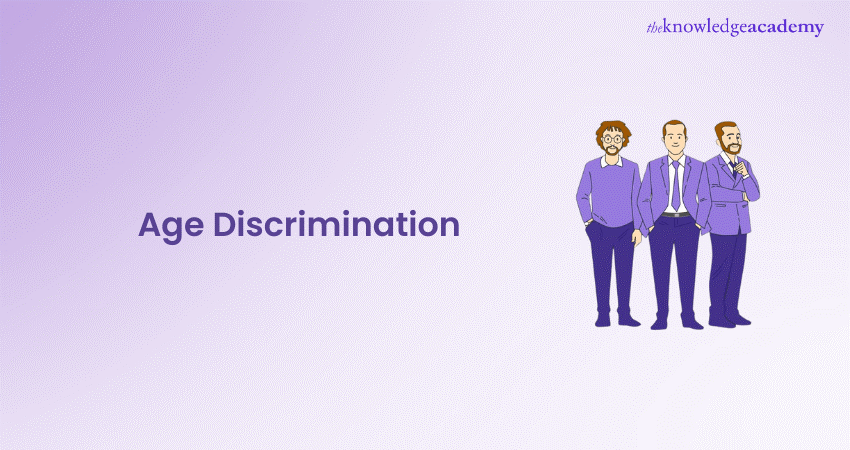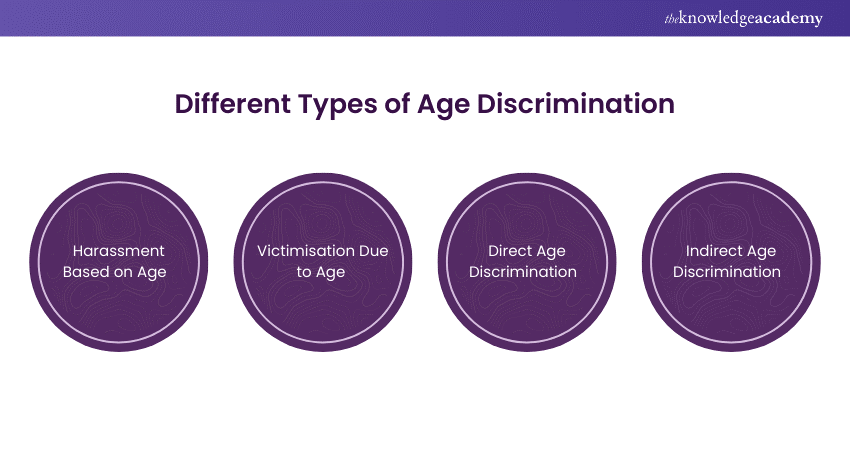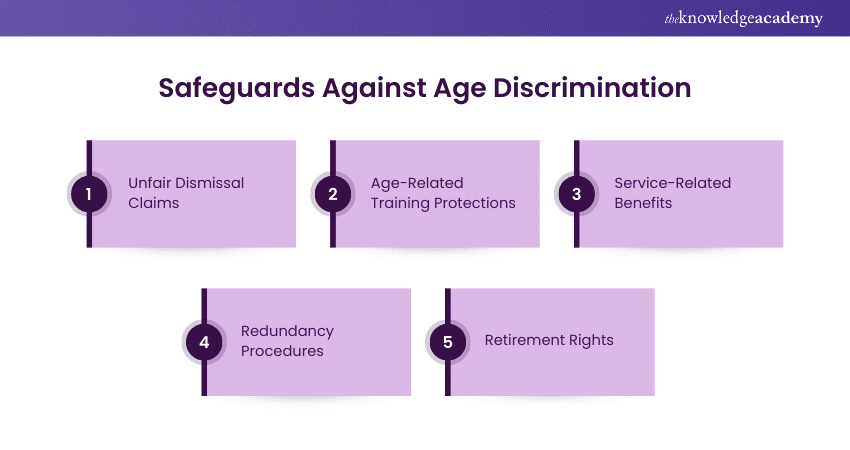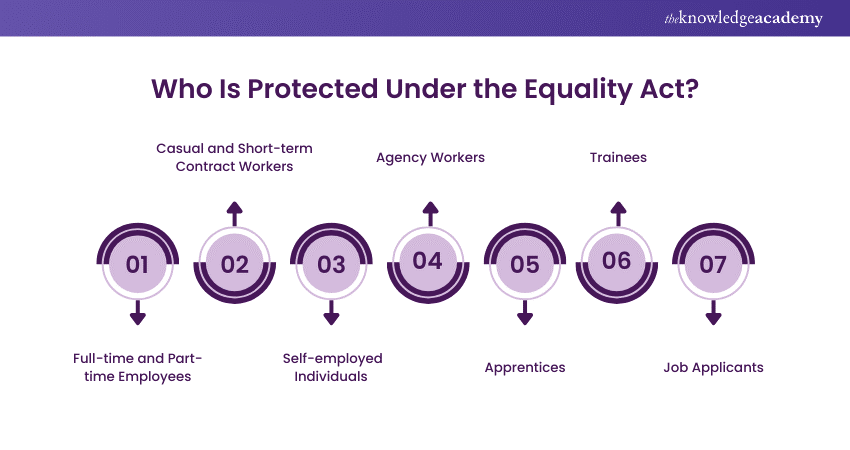We may not have the course you’re looking for. If you enquire or give us a call on 01344203999 and speak to our training experts, we may still be able to help with your training requirements.
We ensure quality, budget-alignment, and timely delivery by our expert instructors.

Imagine being passed over for a job or promotion simply because of your age or enduring unfair comments and treatment at work. These are clear examples of Age Discrimination, and they can significantly impact your career and well-being.
Age Discrimination is a serious and widespread issue that affects many workplaces and other areas of life. Despite laws designed to prevent unfair treatment based on age, it’s essential to understand your rights and recognise how discrimination can occur.
This blog will delve into the various forms of Age Discrimination, explain who is protected under the law, and highlight the safeguards in place to protect you.
Table of Contents
1) What is Age Discrimination?
2) Different Types of Age Discrimination
3) Safeguards Against Age Discrimination
4) Who is Protected Under the Equality Act?
5) Situations Where Age-Based Differentiation is Legal
6) Conclusion
What is Age Discrimination?
Age discrimination involves being treated unfairly based on your age. It can occur in various fields, including:
a) The Workplace
b) Educational institutions
c) Public services
Prevalence: While anyone can experience age discrimination, it is more common among:
a) Older workers
b) Younger workers
Legal Protection in the UK
a) Primary Legislation: The main legal provision against age discrimination in the UK is the Equality Act 2010.
b) Protections Under the Act:
a) The act safeguards individuals from:
i) Direct discrimination based on age
ii) Indirect discrimination based on age
iii) Harassment related to age
b) Exceptions: Age discrimination is only permissible if it can be justified as a proportionate means of achieving a legitimate aim.
Different Types of Age Discrimination
Understanding What Age Discrimination can take gives you a head start on knowing when it's happening. Here, four major categories of Age Discrimination are discussed:

Harassment Based on Age
Harassment involves any unwelcome behaviour related to age that creates a hostile, intimidating, or offensive environment.
a) Examples include:
a) Jokes, offensive remarks, and stereotyping based on a person’s age.
b) Teasing an older employee about their ability to keep up with new technology.
c) Assuming a younger worker is inexperienced.
b) Age harassment can affect both older and younger employees:
a) Comments like “you’re too young to understand.”
b) Excluding someone from responsibilities because they are perceived as inexperienced.
Victimisation Due to Age
Victimisation occurs when someone is treated less favourably because they have reported age discrimination or assisted someone else in reporting it.
a) Examples include:
a) An employee files a formal complaint about ageism, and their supervisor reduces their responsibilities or excludes them from meetings.
Discrimination acts as a deterrent, discouraging Employees from reporting their experiences, which perpetuates further discrimination.
a) The law prohibits retaliation in such cases, and employers are obligated to ensure that employees can raise issues without fear.
Direct Age Discrimination
Direct discrimination happens when a person is treated less favourably because of their age.
a) Examples include:
a) A job application specifies that applicants must be under 40 years old.
b) An employer promotes a younger employee over an equally qualified older colleague based on age.
b) Direct age discrimination is not always unlawful:
a) If a role requires specific physical abilities and a lawful age range is specified, this can be a valid defence.
Indirect Age Discrimination
Indirect discrimination occurs when a policy or practice that applies to everyone disproportionately affects a particular age group.
a) Examples include:
a) Introducing a new training program only for employees who have worked for the organisation for less than three years.
b) Employers must be cautious to avoid indirect age discrimination when implementing policies.
c) Businesses must demonstrate that such policies are reasonable and proportionate when necessary.
Safeguards Against Age Discrimination
Here are some of the significant safeguards that should be known to employees.

Unfair Dismissal Claims
If an employee claims they have been dismissed due to their age, they can file for unfair dismissal.
a) Legal Protection: There is strong legal protection against unfair dismissal, especially for older workers who are more vulnerable to redundancy or retirement due to age.
b) Criteria for Termination:
a) Termination must be based on reasons unrelated to age discrimination.
b) Age cannot be a determining factor for requiring or permitting someone to stay in a particular position.
Age-Related Training Protections
Training should be available to all workers, regardless of age.
a) Discrimination Example: If an employer only trains younger workers, assuming older employees will retire soon, this could be considered discrimination.
b) Growth Opportunities: All employees should have equal opportunities for individual and professional growth without age being a barrier to promotion or skill development.
Service-Related Benefits
Certain benefits are based on the length of service, which can impact different age groups.
a) Examples:
a) Extra holiday entitlement or bonus cash for employees who have been with the company for a certain period.
b) This can disadvantage younger workers who haven’t had time to build up their service.
b) Legal Considerations: Service-related benefits should not discriminate based on age. However, such benefits are not necessarily illegal if justified by business needs, such as rewarding loyalty or experience.
Redundancy Procedures
Decisions to reduce the workforce should not be based on age.
a) Selection Process: Companies must select redundancies based on fair criteria.
b) Indirect Discrimination: If older workers are more likely to be made redundant than younger workers, this could lead to claims of indirect age discrimination.
c) Redundancy Payments: Employers must make redundancy payments fairly and cannot force someone to retire or make them redundant based on age.
Retirement Rights
There is no mandatory retirement age in the UK; employees have the right to decide when to retire.
a) Employer Obligations: Employers cannot force an individual to retire at a certain age unless it is objectively justifiable.
b) Discrimination Claims: Forcing retirement at an unjustified age is considered a prima facie case of age discrimination.
Age Discrimination in the Workplace
a) Common Form of Bias: Age bias is prevalent in Recruitment, promotions, and redundancies.
b) Employer Responsibility: Employers must foster an inclusive environment free from age-related barriers.
a) Fair Recruitment: Ensure unbiased hiring practices.
b) Training Access: Provide equal training and development opportunities.
c) Avoid Sidelining: Do not favour younger workers over older ones.
c) Employee Rights: Workers should be aware of their rights and encouraged to report age discrimination.
d) Open Communication: Promote dialogue between employees and management to prevent discrimination.
e) Training Opportunity: Join our Direct & Indirect Discrimination Training to combat workplace discrimination.
Gain the skills to combat workplace discrimination. Join in our Direct & Indirect Discrimination Training now!
Who is Protected Under the Equality Act?
Under the Equality Act 2010 everyone employed, either looking for work or volunteering, in the United Kingdom will be protected against Age Discrimination. Those individuals fall within the categories of:

1) Employees, whether full-time or part-time
2) Casuals and those employed under short-term or fixed-term contracts
3) Self-employed persons
4) Agency workers
5) Apprentices
6) Trainees
7) Job applicants
Protection Scope: Ensures equality in the workplace and other life areas, prohibiting direct and indirect age discrimination, harassment, and victimisation.
Situations Where Age-Based Differentiation is Legal
a) Exceptions to the Rule: Certain situations allow age-related discrimination if objectively justified.
a) Job Requirements: Age conditions may apply for roles needing high physical fitness or stamina.
b) Service-Related Benefits: Employers can offer benefits based on the length of service if it meet a legitimate business need.
c) Retirement: Compulsory retirement ages can be justified if they meet a legitimate business need and are proportionate.
Navigate legal complexities! Our Commercial Law Training equips you with the knowledge to succeed. Register now for a brighter future.
Conclusion
While Age Discrimination is still the biggest challenge that any person may face, it doesn't matter if a person is younger or older. There is proper legal protection made to treat people fairly through the Equality Act 2010. Knowing rights, different forms of discrimination based on age, and protections against such practice will strengthen citizens and give them an opportunity to fight for just treatment and a more inclusive society.
Become the go-to expert on employment law! Join our Employment Law Training today and safeguard yourself and your team.
Frequently Asked Questions
How to Handle Age Discrimination Complaints?

Handling Age Discrimination complaints involves treating them seriously. Document the incidents, gather evidence, and follow your company’s grievance procedure. If unresolved, seek external advice from legal professionals or ACAS, and consider an employment tribunal if necessary.
Is it illegal to ask for an Applicant’s Age During Recruitment?

Yes, it is generally unlawful to ask for an applicant’s age during recruitment, as this could lead to discrimination. Employers should focus on qualifications and experience rather than age, except when age is a legitimate occupational requirement.
What are the Other Resources and Offers Provided by The Knowledge Academy?

The Knowledge Academy takes global learning to new heights, offering over 3,000 online courses across 490+ locations in 190+ countries. This expansive reach ensures accessibility and convenience for learners worldwide.
Alongside our diverse Online Course Catalogue, encompassing 19 major categories, we go the extra mile by providing a plethora of free educational Online Resources like News updates, Blogs, videos, webinars, and interview questions. Tailoring learning experiences further, professionals can maximise value with customisable Course Bundles of TKA.
What is The Knowledge Pass, and How Does it Work?

The Knowledge Academy’s Knowledge Pass, a prepaid voucher, adds another layer of flexibility, allowing course bookings over a 12-month period. Join us on a journey where education knows no bounds.
What are the Related Courses and Blogs Provided by The Knowledge Academy?

The Knowledge Academy offers various HR Courses, including the Certified HR Advisor, Certified Training and Development Manager, and Category Management Training. These courses cater to different skill levels, providing comprehensive insights into Employee Rights and Responsibilities.
Our Business Skills Blogs cover a range of topics related to Employee Rights and Responsibilities, offering valuable resources, best practices, and industry insights. Whether you are a beginner or looking to advance your Business skills, The Knowledge Academy's diverse courses and informative blogs have got you covered.
Upcoming HR Resources – Learn about Human Resources Batches & Dates
Date
 Direct and Indirect Discrimination Training
Direct and Indirect Discrimination Training
Fri 23rd May 2025
Fri 25th Jul 2025
Fri 26th Sep 2025
Fri 28th Nov 2025






 Top Rated Course
Top Rated Course



 If you wish to make any changes to your course, please
If you wish to make any changes to your course, please


